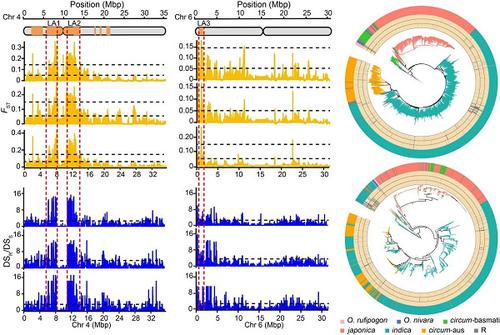当前位置:
X-MOL 学术
›
J. Integr. Plant Biol.
›
论文详情
Our official English website, www.x-mol.net, welcomes your
feedback! (Note: you will need to create a separate account there.)
Balancing selection and wild gene pool contribute to resistance in global rice germplasm against planthopper
Journal of Integrative Plant Biology ( IF 9.3 ) Pub Date : 2021-07-24 , DOI: 10.1111/jipb.13157 Cong Zhou 1 , Qian Zhang 1 , Yu Chen 1 , Jin Huang 1 , Qin Guo 1 , Yi Li 1 , Wensheng Wang 2, 3 , Yongfu Qiu 4 , Wei Guan 1 , Jing Zhang 1 , Jianping Guo 1 , Shaojie Shi 1 , Di Wu 1 , Xiaohong Zheng 1 , Lingyun Nie 1 , Jiaoyan Tan 1 , Chaomei Huang 1 , Yinhua Ma 1 , Fang Yang 1 , Xiqin Fu 5 , Bo Du 1 , Lili Zhu 1 , Rongzhi Chen 1 , Zhikang Li 2, 3 , Longping Yuan 5 , Guangcun He 1
Journal of Integrative Plant Biology ( IF 9.3 ) Pub Date : 2021-07-24 , DOI: 10.1111/jipb.13157 Cong Zhou 1 , Qian Zhang 1 , Yu Chen 1 , Jin Huang 1 , Qin Guo 1 , Yi Li 1 , Wensheng Wang 2, 3 , Yongfu Qiu 4 , Wei Guan 1 , Jing Zhang 1 , Jianping Guo 1 , Shaojie Shi 1 , Di Wu 1 , Xiaohong Zheng 1 , Lingyun Nie 1 , Jiaoyan Tan 1 , Chaomei Huang 1 , Yinhua Ma 1 , Fang Yang 1 , Xiqin Fu 5 , Bo Du 1 , Lili Zhu 1 , Rongzhi Chen 1 , Zhikang Li 2, 3 , Longping Yuan 5 , Guangcun He 1
Affiliation

|
Interactions and co-evolution between plants and herbivorous insects are critically important in agriculture. Brown planthopper (BPH) is the most severe insect of rice, and the biotypes adapt to feed on different rice genotypes. Here, we present genomics analyses on 1,520 global rice germplasms for resistance to three BPH biotypes. Genome-wide association studies identified 3,502 single nucleotide polymorphisms (SNPs) and 59 loci associated with BPH resistance in rice. We cloned a previously unidentified gene Bph37 that confers resistance to BPH. The associated loci showed high nucleotide diversity. Genome-wide scans for trans-species polymorphisms revealed ancient balancing selection at the loci. The secondarily evolved insect biotypes II and III exhibited significantly higher virulence and overcame more rice varieties than the primary biotype I. In response, more SNPs and loci evolved in rice for resistance to biotypes II and III. Notably, three exceptional large regions with high SNP density and resistance-associated loci on chromosomes 4 and 6 appear distinct between the resistant and susceptible rice varieties. Surprisingly, these regions in resistant rice might have been retained from wild species Oryza nivara. Our findings expand the understanding of long-term interactions between rice and BPH and provide resistance genes and germplasm resources for breeding durable BPH-resistant rice varieties.
中文翻译:

平衡选择和野生基因库有助于全球水稻种质对飞虱的抗性
植物和食草昆虫之间的相互作用和共同进化在农业中至关重要。褐飞虱(BPH)是水稻中最严重的害虫,其生物型适应不同水稻基因型的捕食。在这里,我们对全球 1,520 种水稻种质进行基因组学分析,分析其对三种 BPH 生物型的抗性。全基因组关联研究确定了 3,502 个单核苷酸多态性 (SNP) 和 59 个与水稻 BPH 抗性相关的基因座。我们克隆了一个以前未知的基因Bph37这赋予了对 BPH 的抵抗力。相关基因座显示出高核苷酸多样性。跨物种多态性的全基因组扫描揭示了基因座的古老平衡选择。与主要生物型 I 相比,二次进化的昆虫生物型 II 和 III 表现出显着更高的毒力并克服了更多的水稻品种。作为响应,水稻中进化出更多的 SNP 和基因座以抵抗生物型 II 和 III。值得注意的是,在 4 号和 6 号染色体上具有高 SNP 密度和抗性相关基因座的三个特殊大区域在抗性和易感水稻品种之间显得不同。令人惊讶的是,抗性水稻中的这些区域可能保留自野生物种Oryza nivara. 我们的研究结果扩大了对水稻和 BPH 之间长期相互作用的理解,并为培育持久的 BPH 抗性水稻品种提供了抗性基因和种质资源。
更新日期:2021-07-24
中文翻译:

平衡选择和野生基因库有助于全球水稻种质对飞虱的抗性
植物和食草昆虫之间的相互作用和共同进化在农业中至关重要。褐飞虱(BPH)是水稻中最严重的害虫,其生物型适应不同水稻基因型的捕食。在这里,我们对全球 1,520 种水稻种质进行基因组学分析,分析其对三种 BPH 生物型的抗性。全基因组关联研究确定了 3,502 个单核苷酸多态性 (SNP) 和 59 个与水稻 BPH 抗性相关的基因座。我们克隆了一个以前未知的基因Bph37这赋予了对 BPH 的抵抗力。相关基因座显示出高核苷酸多样性。跨物种多态性的全基因组扫描揭示了基因座的古老平衡选择。与主要生物型 I 相比,二次进化的昆虫生物型 II 和 III 表现出显着更高的毒力并克服了更多的水稻品种。作为响应,水稻中进化出更多的 SNP 和基因座以抵抗生物型 II 和 III。值得注意的是,在 4 号和 6 号染色体上具有高 SNP 密度和抗性相关基因座的三个特殊大区域在抗性和易感水稻品种之间显得不同。令人惊讶的是,抗性水稻中的这些区域可能保留自野生物种Oryza nivara. 我们的研究结果扩大了对水稻和 BPH 之间长期相互作用的理解,并为培育持久的 BPH 抗性水稻品种提供了抗性基因和种质资源。











































 京公网安备 11010802027423号
京公网安备 11010802027423号